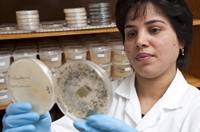Putting the good oil on wood
Scientists at Rotorua’s Crown Research Institute, Scion, have been testing ways to prevent the growth of mould in homes and preserve timber using natural treatments.
“We started by testing more than 100 compounds that showed promise as potential wood preservatives”, says bio-preservation scientist Dr Tripti Singh. “Our laboratory work paid off with a handful of essential oils identified as lead candidates for further testing.
Plant-based essential oils have been used as medicines and have attracted research attention to help prevent food spoilage. These plant oils are labelled ‘essential’ because they frequently give a plant its distinctive scent, such as the aroma of manuka.
In their first experiment, Dr Singh and her team bought several dozen Gypsum wallboards from a local hardware store which they either left bare, painted or wallpapered. These boards were then treated with a range of essential oils or remained untreated. Six boards per treatment were sprayed with spores of the most common household mould and stored in a warm, humid dark-room (similar to a mushroom farm) for 12 weeks.
Around 90% of the boards that were bare or painted were covered with mould after 12 weeks. Wallpapering proved surprisingly effective at preventing mould growth with only 10% of the wallpapered board area covered with mould. All of the boards treated with the oils had virtually no mould growth.
Dr Singh and her team then tested if these essential oils could be a valuable timber preservative. In a near identical method to the Gypsum board study, they tested exposed pine wood blocks to rot fungi and again tested several essential plant oils as potential preservatives.
“These essential oils preserved the wood spectacularly well compared with untreated samples,” says Dr Singh.
However, when these treated samples were exposed to water for several days, the oils were leached out of the wood. Dr Singh and her team, together with an industry partner, are evaluating ways to overcome the leaching issue.
The sweet smell of success from this research will be healthier homes that are less prone to decay and mould as well as naturally-preserved timber products that can be exported to high value export markets.

